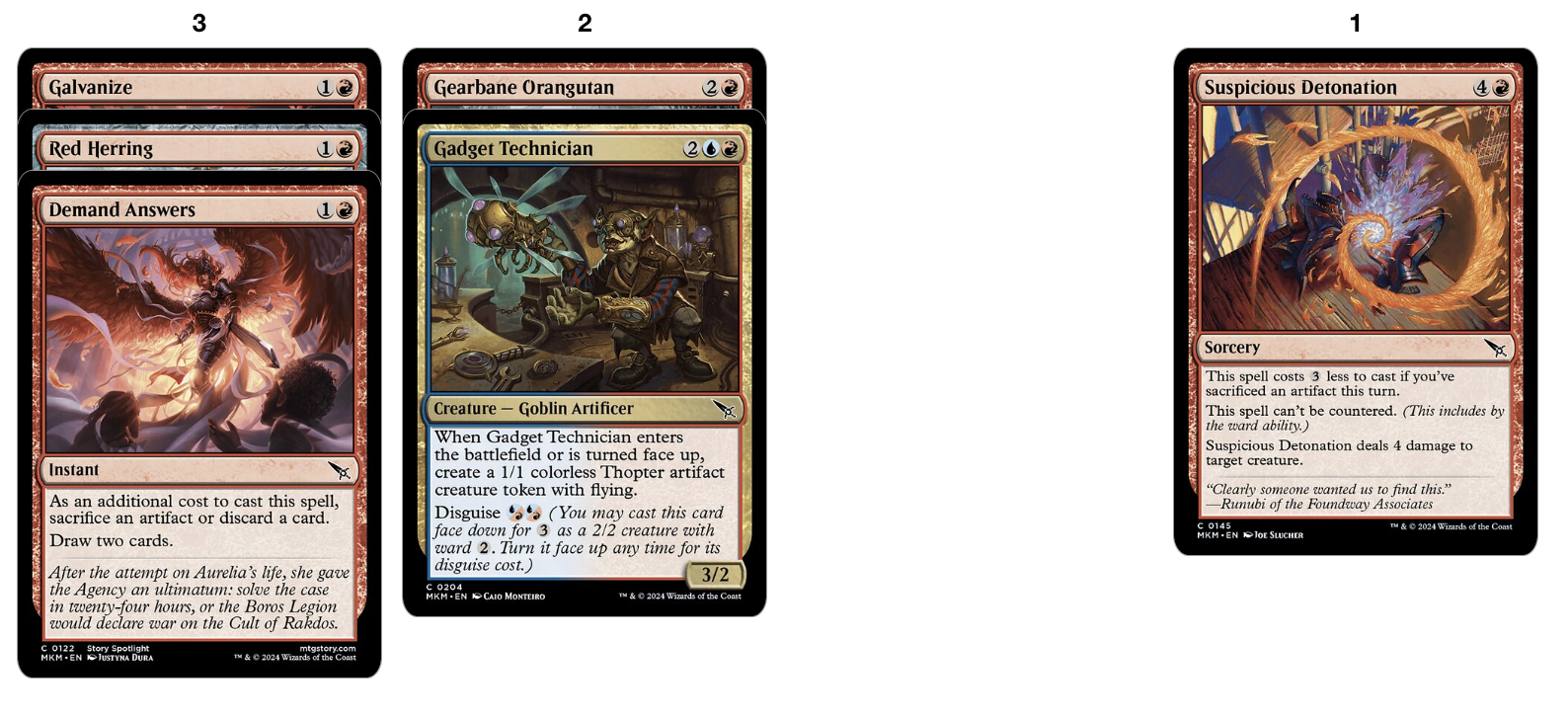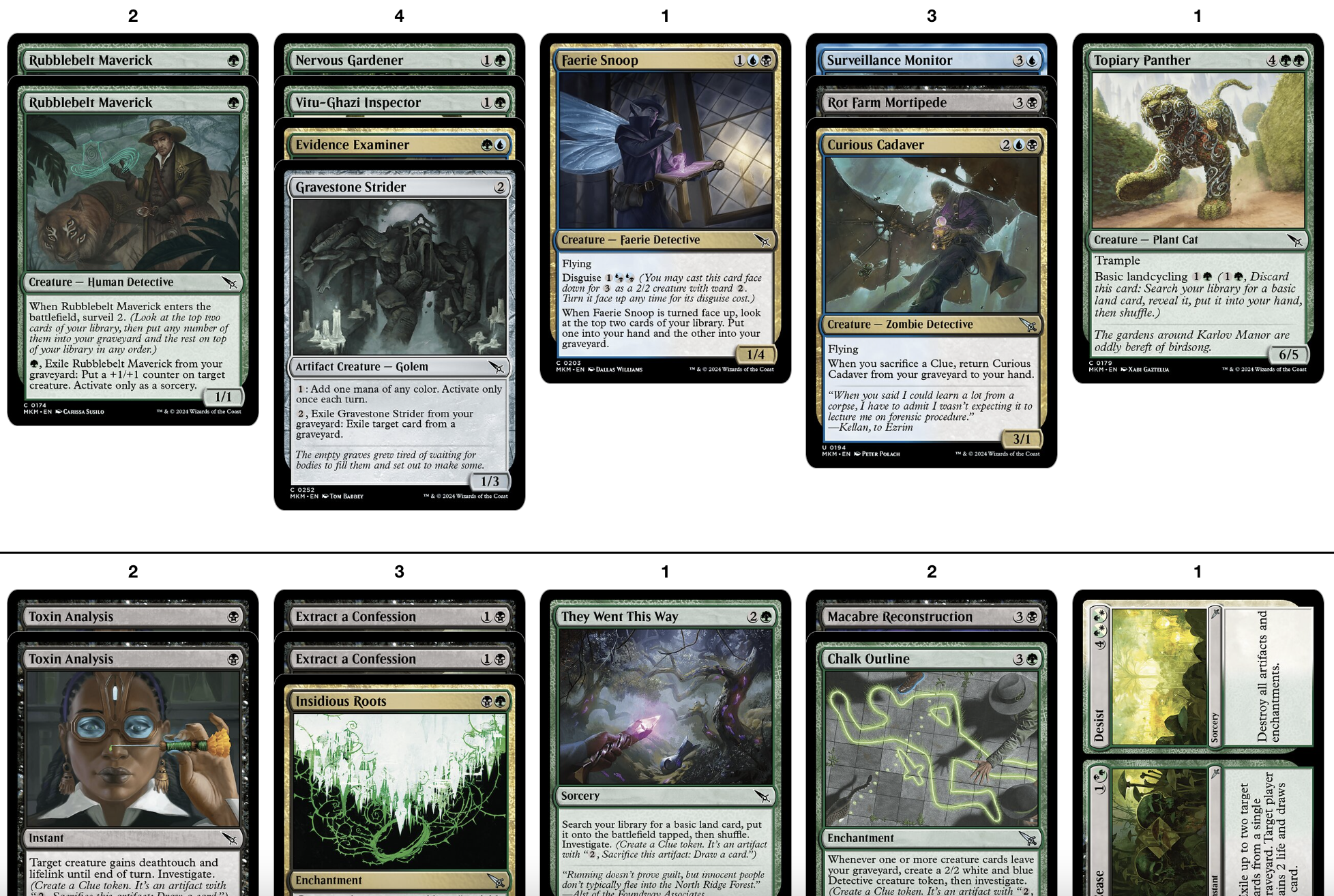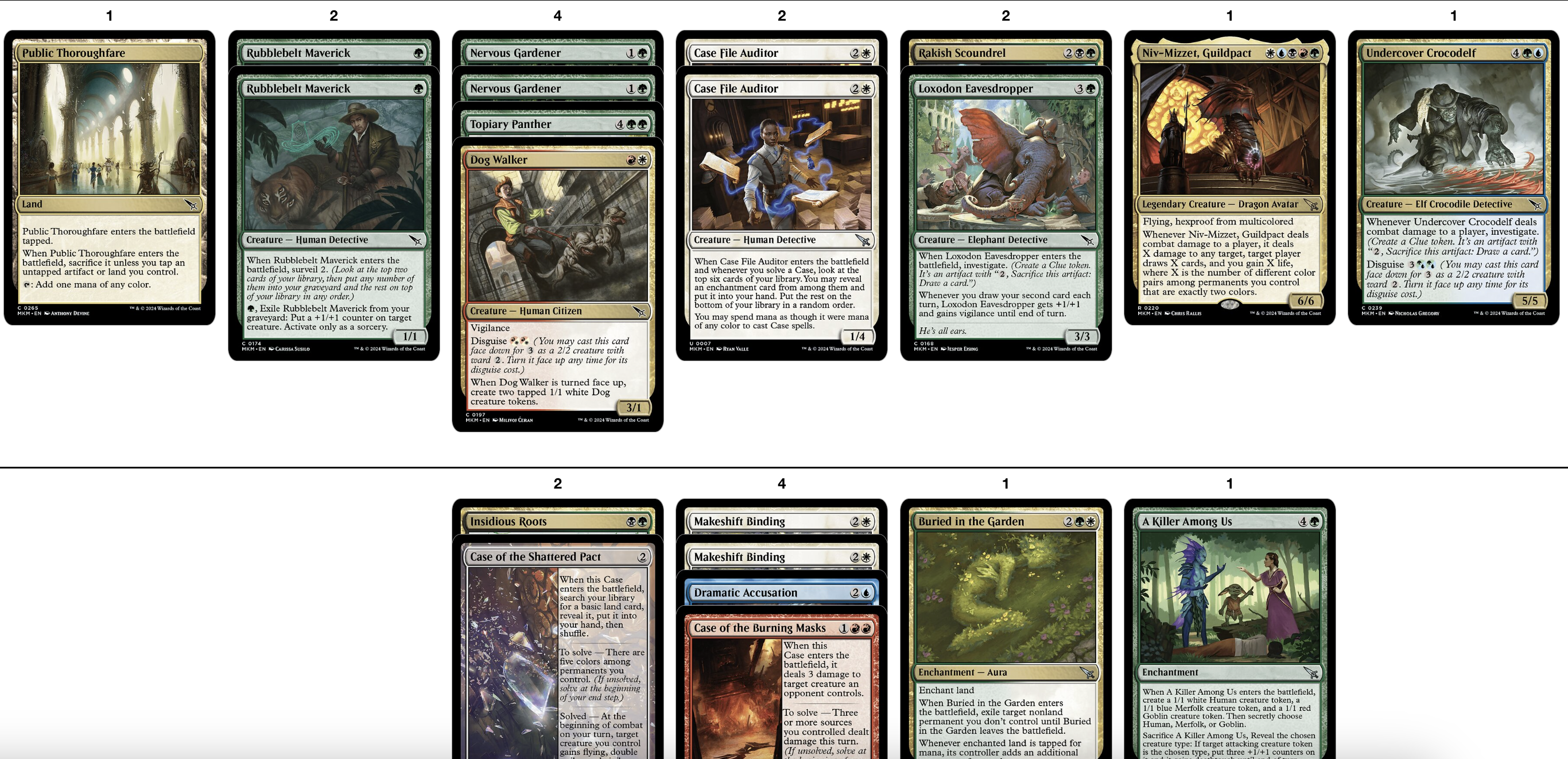MKM Archetype Skeletons
01/28/2024
I always love the weeks around a new set release; diving into and exploring a new set is one of my favorite things to do in Magic. And this set is one I am especially excited and incentivized to figure out, as it's the format of the PT I'm qualified for!
So this week, I'm starting out with one of the best ways to familiarize yourself with a set before its release: building out some archetype skeletons.
What are Archetype Skeletons?
The idea behind this exercise is to try to build a "skeleton" deck for each draft archetype, to try and see how all the cards fit together. This way, you can get a sense of how well-supported various synergies are, how various cards fit into various archetypes and color-pairs, and just in general get a better sense for the set.
I've been doing this for quite a while now - in fact, I'm usually on a once-per-set Archetype Skeletons stream with Sierkovitz, SLKersten, TaJoordan, ddavp, and others! On those streams we usually talk about what we expect from the various colors in the set, and present archetype skeletons we've each built.
And I'm still going to be doing that this set! We'll be live on Sierkovitz' stream at around 4 PM EST on Monday, 1/29. But I figured I'd also write an article, as I want to go deeper here than we usually do on stream.
Part 1: The Colors
One thing I'm a big fan of, generally, is building out what I call "half-skeletons". Instead of constructing an entire skeleton deck, I lay out half of one - generally with cards of all one color, to demonstrate the big synergy packages in that color.
I like starting here, as we can then see how various colors interface with each other!
White - Going Wide
This was one of the first synergy packages that stood out to me - white at common looks to be all about going wide.
The most notable payoff for this is
On the Job - getting a clue is a huge upside to add to an Inspired Charge effect! Now, you can feel pretty excellent about using this midgame to push through some damage and good trades, in addition to the main use case of producing lethal.On top of that, white has some excellent enablers for going wide.
Dog Walker lets you pay 5 mana in installments for a 3/1 and two 1/1s - an excellent rate that you can get as early as turn 4! Inside Source is less flashy, but also still really solid rate.White also has various ways at common to push through damage with these small creatures -
Makeshift Binding provides very efficient removal for big blockers, and Auspicious Arrival lets you attack through early roadblocks pretty seamlessly.If there was one weakness I'd want to point out here, it's that the early plays are a bit lacking.
Novice Inspector and Marketwatch Phantom are both excellent, and Seasoned Consultant is... okay, but that's fewer cheap plays than we usually see in white at common. Thankfully there are quite a few at uncommon, but still, I think it will be one of the big things to prioritize for this kind of deck.Blue - Flash Tempo?
Blue's synergies are quite a bit less pronounced than white, but there is still definitely something there. Notably, a lot of the good blue cards point at the color wanting to play an instant speed, tempo game.
Out Cold is the headline here, as my current vote for blue's best common. Tapping down two creatures for two turns each is quite a lot of tempo, and it doesn't even cost you a card! I expect you can use this burst of tempo to win in the air with fliers like Cold Case Cracker and Granite Witness.
At the same time, maybe you want to add some flexibility to the 4 mana you're holding up. Then, you can take advantage of the suite of 2 mana instants at common -
Unauthorized Exit, Reasonable Doubt, and Deduce - as well as morph creatures like Faerie Snoop that provide even more ways to spend mana on your opponent's turn.One interesting thing to note here is what is lacking - there's not really a big card draw spell. As such, there likely won't be much in the way of super controlling blue decks.
Red - Sacrificing Artifacts?
Red as a color doesn't look super focused at common. There's plenty of raw power, including premium removal like
Shock and Galvanize. And there's plenty of support for various archetypes - Goblin Maskmaker and big disguise creatures for the Gruul disguise deck; and Person of Interest for the go-wide Boros deck. But it just feels like the synergy doesn't quite come out at common much.The biggest thing I can point to is a focus on clues and sacrificing artifacts in general - all the cards pulled out above deal with artifacts in some way, and this ties into more specific synergy support at uncommon, like with
Harried Dronesmith and Detective's Satchel.However, I do worry that this will be largely concentrated in Izzet, as blue has the most ways by far of making clues - in other colors, it seems a bit difficult to support the red artifact synergies that well. And of course, red can still play an excellent support color with its generically powerful cards, but I am dubious of red giving you all too much direction.
Black and Green - A Whole Lot of Nothing
Speaking of lacking synergy at common - our last two colors really don't have anything interesting going on at common. This isn't to say that they're bad! They have plenty of generically good cards like
Murder and Loxodon Eavesdropper! But again, you're not going to be finding your direction here.Green, though, does at least have fixing.
Nervous Gardener, They Went This Way, and Topiary Panther are all very reasonable ways to fetch basics, and represent quite a lot of fixing available at common if you want it.Part 2: The Spice
Now, I could spend the rest of this article going through each of the color pairs and putting together some basic skeletons for each of those archetypes. But that wouldn't be all that interesting, I think - it's not hard to add red cards to the white half-skeleton, or add blue cards to the red half-skeleton, or just jam together the good cards in each color pair. Plus, if you want to see that, you'll probably already get most of it tomorrow in the Archetype Skeletons stream - I don't want this to just be a prehash of that.
So instead, what I'm going to do is focus on the spice. It's not that hard to put a bunch of blue and white detectives in a deck - but how do you build around
Chalk Outline?Insidious Chalk Evidence
From a certain point of view,
Insidious Roots and Chalk Outline are some of the strongest cards in the set. If you can trigger them multiple times, they give quite the insane output - at 3 times, Roots represents a 1/2, 2/3, and 3/4 for 2 mana; and Chalk represents three 2/2s and three clues for 4 mana.Of course, it's not quite that simple, as triggering them certainly isn't trivial. 2 or 4 mana spent on an enchantment that does nothing will lose you the game. So how do you make the juice worth the squeeze?
The biggest enabler here is
Rubblebelt Maverick. As a baseline, this 1 drop is already pretty reasonable - surveil 2 is quite strong, and it represents a cheap 2/2 worth of stats (though you can never have both at the same time).But it really starts to shine when you add it to these synergies - not only does it trigger Roots or Chalk for 1 mana, it also sets you up very well by surveiling towards those synergies.
The next biggest enabler is the "collect evidence" mechanic. Collecting evidence involves exiling cards from your graveyard, so if any of those exiled cards are creatures, you'll trigger Roots and Chalk. Collect Evidence as an archetype is also somewhat adjacent in color - UG is the main color pair, so it's quite natural to splash the sometimes-blue payoffs in this kind of deck.
Evidence Examiner immediately giving you a detective the turn you play Chalk is pretty nice.Of course there's plenty of other one-off ways of triggering Roots and Chalk -
Curious Cadaver being one of the more interesting ones, as it's in some senses "infinite" Chalk triggers since each trigger gives you the clue to buy back the Cadaver again and get another trigger.But the last part of this skeleton that I wanted to highlight is actually the card
Toxin Analysis. I think this will be actually quite key to this kind of deck, as it helps buy a lot of time - and is notably quite a good combo with Rubblebelt Maverick. Using it to trade off the small creatures you get off of Roots and Chalk is no joke either.The Case for Cases
The next card that really piqued my interest is
Case File Auditor. If you can make it draw a card, the rate is quite good - and of course, if you then solve a case, the rate is absurd.Unfortunately, there aren't that many cases in the set - only 7 at uncommon, and 5 at rare/mythic. And most of them are also pretty strong cards, so you might have to fight for them at your table. But at least you can cast cases of all five colors, and the fact that they're strong makes Case File Auditor itself even more appealing!
So since you can't expect to get too many cases, you'll want to fill your deck with more enchantments as well - I'd aim for at least 7 enchantments to make Case File Auditor feel good. Thankfully, there's quite a few good enchantments in the set, including at common!
Makeshift Binding will probably be one of the most important enchantments here, as it's a premium removal spell in your color and at common. Dramatic Accusation also serves as removal, and there are a few at uncommon too.
I elected to have green be my other base color here because it provides fixing, and we'll likely want to touch many colors. This is especially the case (heh) since
Case of the Shattered Pact is one of the cases we're more likely to see - not many other decks want it! Plus, we can combo it with another potent uncommon enchantment - the amogus enchantment - to get 4/5 of the colors needed to solve it!We'll just need some black cards to finish it off - we can get those from hybrid disguises like
Rakish Scoundrel, or other enchantments like Soul Enervation or Insidious Roots. And speaking of Insidious Roots, we can notably fit some of the synergies from the previous deck here, too - Roots and Chalk are both enchantments, and both represent multiple colors for our Shattered Pacts!Shattered Pact and green fixing let us play roughly whatever good cards we might find of any colors - the Niv Mizzet you see in the skeleton is there to represent that, and certainly doesn't need to be exactly Niv Mizzet.
Solving the Conundrum
The last buildaround I want to focus on today is
Living Conundrum. This is essentially this set's version of the library looping archetype - except instead of actually infinitely recurring your library, you win by emptying it and then beating down with a 10/10 in the air.So to make this card work, we mostly want to just be tearing through our deck. And we can make pretty good progress just with all the clues and card advantage, but we probably want a bit more than that - so I turned to surveil.
And for the third time, here's
Rubblebelt Maverick! This little guy is just my favorite green common this set, and it helps bridge together so many of these weird archetypes. In this case, we're using it for the surveil - which will almost always be a mill 2 here if we can help it!To make use of all the cards we're dumping into our graveyard, I've again included some collecting of evidence - and you could include Roots and Chalk too if you get those. But here especially,
Evidence Examiner will shine as a way to churn through your deck, turning milled cards into more drawn cards.On top of all of that, we can make use of some common card draw engines -
Faerie Snoop just to get through 2 cards, and Projektor Inspector to give us a loot on almost every single creature you want anyways in this deck. (yes, the Maverick is a detective too!)We can also use the blue tempo tools I mentioned before to help survive until we get there -
Out Cold and Unauthorized Exit both keep us churning through our deck.And of course, in all of these kinds of decks, you should be prepared with a backup copy of your
Living Conundrum - in this case, that's Macabre Reconstruction, which we can use to get back the Conundrum if it dies or is milled.Conclusion
Hopefully that was a good exhibit of the various buildarounds that MKM can offer. I'm sure there will be more too - the set looks quite deep, with more uncommons than usual. And I didn't even mention any of the rares!
Personally, I'm most excited for trying to build a hybrid case/Chalk deck. I know that's highly specific, but the fact that Case File Auditor finds Chalk just feels so perfect to me, and I think it'll be quite powerful if it ever comes together - making it all come together will be the hard part.
But that'll have to wait until the set releases. For now, all we can do is speculate - and if you want more of this kind of speculation, you can join me, Sierkovitz, and others for plenty of speculation tomorrow at 4 PM EST on Sierkovitz' stream for more (normal) archetype skeletons.
#FreePalestine | Consider donating to UNWRA or PCRF, supporting protesters locally, and educating yourself.






